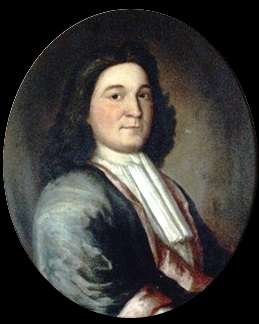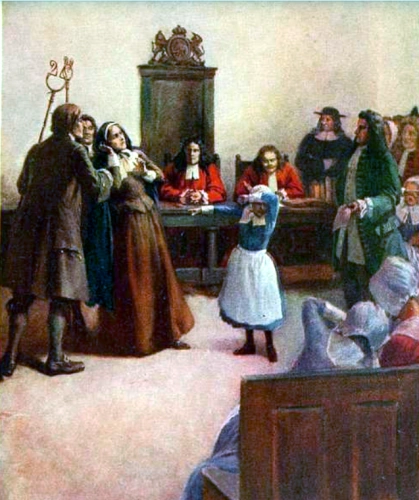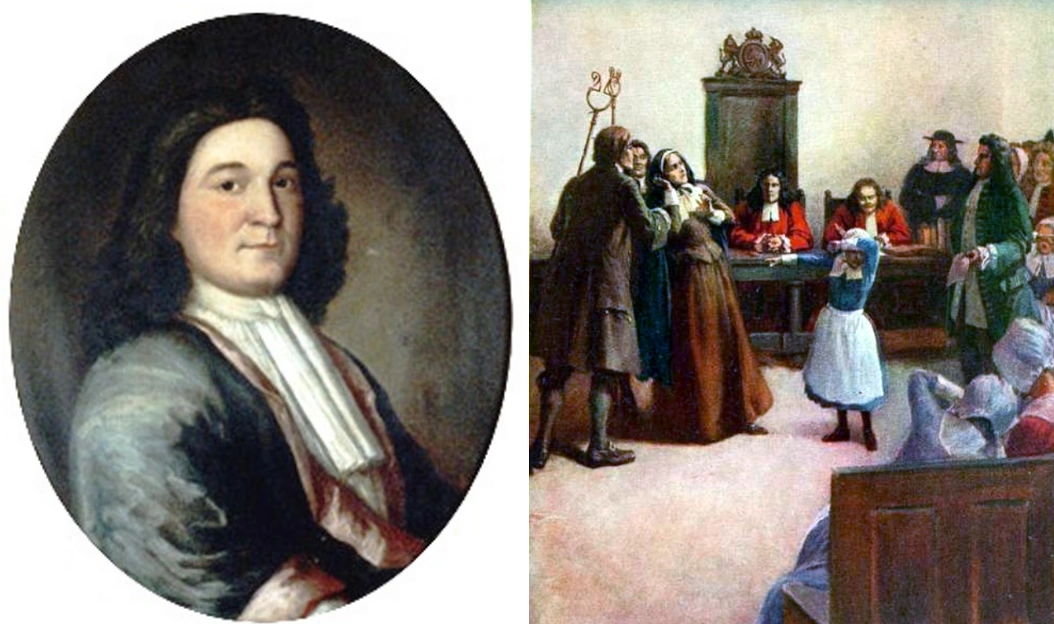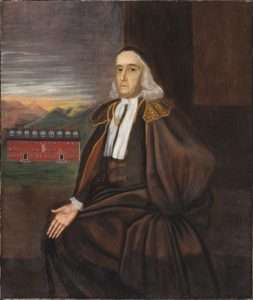On May 27, 1692, Massachusetts’ newly minted governor William Phips established the most famous court of oyer and terminer ever.
Authorities establish a court of oyer and terminer to hear and determine the truth, generally in serious rather than petty crimes.
Phips’ lieutenant governor William Stoughton headed the court of oyer and terminer and took on the task of dealing with the growing scandal in Salem Village. What followed was the most unusual episode of legal history New England ever saw.

William Phips
Court of Oyer and Terminer
In 1692, England and her colonies hadn’t quite recovered from the revolution that overthrew King James II in 1688 and began the reign of William and Mary. The new king and queen busily inserted their own partisans into positions of power. And so the influential Massachusetts minister Increase Mather persuaded the monarchs to install as governor William Phips, a poorly educated shipbuilder and treasure hunter.

Salem, meanwhile, wrestled with a division of its own that had existed for years. The community, torn apart by multiple factions, could not agree on a pastor. No sooner would one faction choose a minister then the rival faction would undermine him.
As the hostilities simmered, townspeople stumbled upon accusations of witchcraft as a useful tool to besmirch the reputations of their enemies. Accusations ran into the hundreds as Phips took charge of the colony. However, the changeover in governance prevented trials from getting underway.
Fighting with the Native American tribes was Gov. Phips’ top priority, and he gave Lt. Gov. William Stoughton responsibility for clearing the backlog of witchcraft cases. Stoughton took the job seriously.
The Slaughter
One of Stoughton’s earliest, and most significant, decisions was to allow the admission of ‘spectral’ evidence (i.e. acts carried out by demons that only an accuser can see). With spectral evidence allowed, Stoughton’s court set about trying and executing witches with astonishing speed.
Stoughton also implemented another rule that moved things along, one that encouraged (or tortured) the accused into confessing that they practiced witchcraft. The court spared those who confessed. Those who would not confess risked death at trial.
And finally, Stoughton sent the jury back to reconsider even when it found an accused witch innocent. The jury, for example, exonerated Rebecca Nourse, Stoughton sent the jurymen back to reconsider, they convicted Nourse and she died on the gallows.
Within two weeks of the court’s establishment, it killed the first alleged witch. Stoughton’s efficiency dovetailed perfectly with the religious leaders’ fervent belief that the devil was attacking the colony. These forces combined to create a powerful killing machine, executing 20 people in just four months with more than 100 prisoners still to try.
End to the Slaughter
The slaughter might have continued had Governor Phips not returned to his senses and put a stop to the lunacy. The bloodshed had finally grown too much for the ministers of the day. They conceded that perhaps innocents were being killed.
The ministers urged Phips to act as the allegations continued to fly, including charges against Phips’ own wife.
In September 1692, Phips ended the court of oyer and terminer, stopping the trials and eventually freeing all the prisoners.
In the aftermath, Phips, as did many of those involved, apologized for his actions. Stoughton, however, never publicly admitted any wrongdoing. A life-long political operator, he continued accumulating wealth and political power until his death in 1701. He willed his estate to Harvard College.
This story about the court of oyer and terminer was updated in 2022.


18 comments
It’s a shame this ever happened!
I believe Phips “returned to his senses” because his own wife was accused of showing signs of witchcraft. Otherwise, who knows how long it might have continued.
The words “to his senses” in the following sentence should be omitted, because the Gov. had been away from Salem (as the post noted) and literally returned and saw what was happening — and yes, his wife was accused and he did realize it was all misguided: “The slaughter might have continued had Gov. Phips not returned to his senses and put a stop to the lunacy.”
My ancestor, Susannah North Martin, was one of the victims.
Susannah North Martin was my 11th great-grandmother…Henry Herrick, 9th great-grandfather, served on the jury
I’ve always felt “ashamed” for that part of our History. It shouldn’t have happened.
[…] built in 1729 as a Puritan meeting house. Samuel Sewall publicly apologized for taking part in the Salem Witch Trials there. Benjamin Franklin was baptized on the site. Phyllis Wheatley thought about freedom while […]
[…] of witchcraft had been flying through Salem since late February. On May 27, 1692, a court of oyer and terminer was commissioned to hold the infamous Salem witch trials. By then, Mary had already been […]
[…] they testified against Bridget Bishop, the first victim. But Maule grew disillusioned with the prosecutors’ murderous frenzy. Twenty people were executed within four months, and 100 more awaited trial when Gov. William Phips […]
[…] In 1662, William Hoare of Beverly, Mass., was brought to court for hosting a drunken gathering on Christmas Day. Hoare was a troublemaker whose family was frequently at odds with Puritan society — eventually their attitudes would cost his wife her life, as she was hanged as a witch in the Salem witch frenzy 30 years later. […]
[…] one of the most important horror novels of the 20th century. She wrote a book for children about the Salem witch trials called Witchcraft of Salem […]
[…] witch trials today are more popular than ever. Since 2000 alone, the Salem witch trials have been the subject of no fewer than 10 books, 14 rock songs, seven films, three video games and […]
[…] was also struck by a story about two college boys who went to watch the Salem witch trials. “Both boys burst out laughing at some absurd testimony: they were promptly jailed, and faced […]
[…] out punishments for specific crimes. Several crimes carried the death penalty: treason, murder, witchcraft, arson, sodomy, rape, bestiality, adultery, and cursing or smiting one's […]
[…] 1692 and 1693, the courts of Massachusetts did indeed order the deaths of 20 people for witchcraft. Two hundred (perhaps a few more) were […]
[…] In the two centuries since, hundreds if not thousands of plays, long poems and novels have grappled with the Salem witch trials. […]
[…] Court of Oyer and Terminer was formed to investigate the disturbances in Salem. (Read more about it here.) The court quickly turned into a killing […]
[…] explains the abundance of famous Salem witch trials descendants. Gov. William Phips appointed a Court of Oyer and Terminer to deal with the witchcraft accusations in February 1692. Nineteen were hanged on Proctor’s […]
Comments are closed.